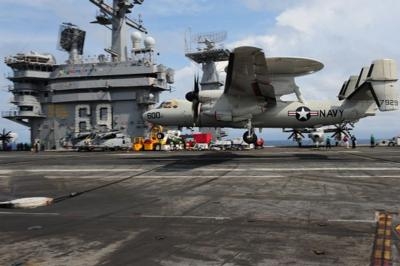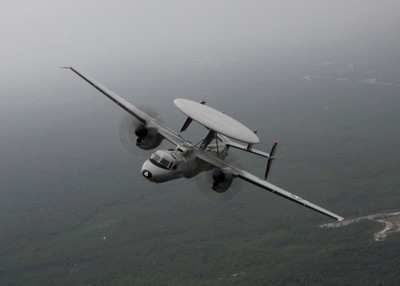Units Conducting Four Weeks Of Operational Analysis
Air Test and Evaluation Squadron (VX) 1 combined forces with
Carrier Airborne Early Warning Squadron (VAW) 120 to bring a joint
detachment to Naval Air Station Jacksonville Jan. 16, to help meet
its schedule for the E-2D Hawkeye Initial Operational Test and
Evaluation. The squadrons are conducting four weeks of operational
evaluations in conjunction with the USS Enterprise (CVN 65)
Composite Training Unit Exercise (COMPTUEX) and Joint Task Force
Exercise (JTFEX) underway in the Atlantic Ocean.

The new Northrop Grumman E-2D Hawkeye is the Navy's latest
carrier-based airborne early warning, battle management command and
control system that works in concert with surface ships equipped
with the Aegis combat system. "The Hawkeye is highly valued by
admirals who want to know what friends and foes are in the vicinity
of their carrier strike group. Where naval surface ship
surveillance systems like Aegis can only see as far as the horizon,
VAW aircraft fly above the curvature of the earth to provide the
strike group's command and control leadership with a more expansive
look of potential battle spaces," said Officer-in-Charge Lt. Cmdr.
Dave Champaigne of VAW-120.
VX-1 E-2D Operational Test Director Lt. Cmdr. Greg Harkins said,
"The new E-2D Advanced Hawkeye is able to scan a larger area,
detect smaller targets, process data about those targets faster,
and transform all of that information into improved situational
awareness for strike group leadership."
"This is an unusual mission for VAW-120. We're glad to assist our
brethren at VX-1 and help keep the fleet introduction of the E-2D
on schedule," Champaigne said.
VAW-120, based at Naval Station Norfolk Chambers Field, is the
fleet replacement squadron (FRS) for the E-2C and E-2D Hawkeyes,
and the C-2A Greyhound. The FRS is responsible for training pilots,
naval flight officers (NFOs) and maintenance personnel for fleet
operational squadrons. "The tasking of our joint detachment at NAS
Jax comes to VX-1 from Commander Operational Test and Evaluation
Force (COMOPTEVFOR) and Commander Strike Force Training Atlantic
(CSFTL). VX-1, based at NAS Patuxent River, Md., is in the midst of
a big wave of operational evaluations that include programs for the
P-3C and the new P-8A platform -in addition to programs for C-2A,
E-2C and the new E-2D platform," explained Harkins.

"VAW-120 acts as a trusted agent for VX-1. Our job is to
determine how well the E-2D compares to what the Navy asked for,
and how it operates in the real world as opposed to a controlled
test environment," Champaigne said. "We're already getting
qualitative assessments from aircrew and maintainers, including
good feedback on the glass cockpit. NFOs are liking the large
17-inch monitors at their workstations, as well as the option for
the co-pilot to plug in as a fourth mission systems
operator."
Over the next six months, the detachment will travel around the
country to evaluate how it functions in large-force exercises,
strike group and air wing exercises and joint exercises. During
their time in Jacksonville, the squadrons will be part of the
Enterprise JTFEX, the strike group's final operational exam before
being certified for overseas combat operations. "Since E-2s have
the biggest footprints on the flight deck, the Enterprise air boss
isn't going to be happy when we add two more to the mix. But they
understand we're doing these tests to provide a new and improved
platform to the fleet. So, we'll put two E-2Ds on board Enterprise
and fly our other pair from NAS Jacksonville," said Harkins.
"To this point, the aircraft has proven it can meet developmental
requirements. Now it's up to this detachment to assess everything
in a more fluid and realistic operational environment," said
Champaigne.
 NTSB Final Report: Dehavilland DHC-2 MK 1
NTSB Final Report: Dehavilland DHC-2 MK 1 Aero-News: Quote of the Day (10.29.25)
Aero-News: Quote of the Day (10.29.25) ANN's Daily Aero-Linx (10.29.25)
ANN's Daily Aero-Linx (10.29.25) ANN's Daily Aero-Term (10.30.25): Minimum Friction Level
ANN's Daily Aero-Term (10.30.25): Minimum Friction Level ANN's Daily Aero-Linx (10.30.25)
ANN's Daily Aero-Linx (10.30.25)




